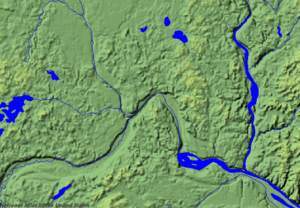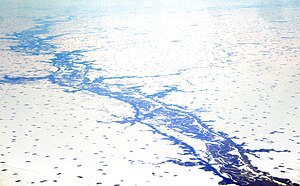Glacial River Warren
Glacial River Warren, also known as River Warren, was a prehistoric river that drained Lake Agassiz in central North America between about 13,500 and 10,650 BP calibrated (11,700 and 9,400 14C uncalibrated) years ago.[1] A part of the uppermost portion of the former river channel was designated a National Natural Landmark in 1966.[2]
Geological history
[edit]


Lake Agassiz was formed from the meltwaters of the Laurentide Ice Sheet during the Wisconsin glaciation of the last ice age. Agassiz was an enormous body of water, up to 600–700 ft (180–210 m) deep, and at various times covering areas totaling over 110,000 sq mi (280,000 km2).[3] Blocked by an ice sheet to the north, the lake water rose until about 13,500 BP calibrated (11,700 14C uncalibrated) years ago when it overtopped the Big Stone Moraine, a ridge of glacial drift left by the receding glacier, at the location of Browns Valley, Minnesota. The lake's outflow was catastrophic,[4] and carved a gorge through the moraine 1 mi (1.6 km) wide and 130 ft (40 m) deep, which is now known as the Traverse Gap.[5] The channel through the moraine, between Lake Traverse and Big Stone Lake, is now crossed by the divide between the watersheds of the Gulf of Mexico and Hudson Bay. Its significance was recognized by designation as a National Natural Landmark under the Historic Sites Act.[6]
From Traverse Gap issued Glacial River Warren. From its inception until final abandonment of Agassiz' southern outlet, this stream drained the meltwater of that lake to the Mississippi valley. The drainage was not continuous, as Lake Agassiz periodically had other outlets. The Laurentide Ice Sheet retreated and advanced with climatic variations and these changes in ice cover contributed to isostatic adjustments in the level of the land over which the watercourses ran. These changes in turn uncovered or blocked the lake's other outlets to the sea.[7]
Course
[edit]While active this turbulent stream cut and eroded a bed up to 5 mi (8.0 km) wide and 250 ft (76 m) deep,[8] leaving a valley which starts at Traverse Gap near Browns Valley, Minnesota, goes southeast to Mankato, then turns northeast to the Twin Cities. River Warren was joined by the comparatively small Mississippi at Fort Snelling, from which the valley continues northeast to present-day Saint Paul, where the massive River Warren Falls once graced the landscape. Over 1700 years this waterfall retreated upstream and undercut the Mississippi at the site of Fort Snelling. The falls then split. The Mississippi falls migrated upstream to form Saint Anthony Falls and create Minnehaha Falls in Minneapolis. The River Warren falls receded west in the Minnesota River valley until they reached an older buried river valley about 2 mi (3.2 km) west of the confluence, where the falls were extinguished.[9]
From Saint Paul the great valley goes southeast to Prescott, Wisconsin, where it is joined by the St. Croix River, itself once the outlet of another proglacial lake, Glacial Lake Duluth which occupied the western part of Lake Superior. From its confluence with the St. Croix the valley continues southeast along the Minnesota–Wisconsin border. River Warren's effects include the creation of bluffs along the valleys of the Minnesota and Mississippi Rivers, and contributed to the formation of Lake Pepin.[10]
Disappearance
[edit]By about 9400 BP, the ice sheet finally retreated sufficiently far to the north that Lake Agassiz permanently took another outlet and receded below the level of Traverse Gap. River Warren then ceased to run.[11] The Lake Agassiz area watershed now feeds the Red River of the North which flows north, ultimately to Hudson Bay. River Warren's upper valley in the Traverse Gap is now occupied by the tiny Little Minnesota River, which flows into Big Stone Lake and the Minnesota River, which follows the greater river's ancient bed to its confluence with the Mississippi River. These misfit streams occupy only a small cross-section of River Warren's riverbed.[12]
Name
[edit]The hydrology of the oversized valley was first explained by General G. K. Warren in 1868. He made a detailed survey of the valley in his search for possible transcontinental railroad routes.[13] In appreciation of this work, the glacial river that was the outlet of Lake Agassiz was named River Warren.[14]
See also
[edit]- Geology of Minnesota
- Glacial history of Minnesota
- Laurentide Ice Sheet
- Proglacial lakes of Minnesota
- Warren Upham
References
[edit]Notes
[edit]- ^ Fisher, River Warren Boulders, pp. 348, 350.
- ^ "National Natural Landmarks – National Natural Landmarks (U.S. National Park Service)". www.nps.gov. Retrieved 2019-03-27.
Year designated: 1966
- ^ Lusardi, Quaternary Glacial Geology, pp. 3–4; Sansome, Minnesota Underfoot, p. 175. The area actually inundated at one time was somewhat less.
- ^ Fisher, River Warren Boulders, pp. 348, 350.
- ^ Sansome, Minnesota Underfoot, pp. 174–75; Upham, The Glacial Lake Agassiz Archived 2001-01-21 at the Wayback Machine, pp. 14–17.
- ^ "Ancient River Warren Channel". NNL Guide-Minnesota. National Park Service. Archived from the original on 2013-03-06. Retrieved 2013-04-01.
- ^ Fisher, River Warren Boulders, p. 351.
- ^ Sansome, Minnesota Underfoot, pp. 118–19.
- ^ Waters, The Streams and Rivers of Minnesota, pp. 226–28.
- ^ Ojakangas, Minnesota's Geology, pp. 110–114.
- ^ Fisher, River Warren boulders, p. 350.
- ^ Valley Formation.
- ^ Gouverneur Kemble Warren Papers, 1848–1882
- ^ Upham, The Glacial Lake Agassiz, pp. 7–8.
Sources
[edit]Books, journals and monographs
[edit]- Fisher, Timothy G. (March 2003). "Chronology of glacial Lake Agassiz meltwater routed to the Gulf of Mexico" (PDF). Quaternary Research. 59 (2). Academic Press: 271–76. Bibcode:2003QuRes..59..271F. doi:10.1016/S0033-5894(03)00011-5. S2CID 130223046. Archived from the original (PDF) on September 10, 2008. Retrieved 2007-07-04. (archived from original)
- Fisher, Timothy G. (December 2004). "River Warren boulders, Minnesota, USA: catastrophic paleoflowindicators in the southern spillway of glacial Lake Agassiz" (PDF). Boreas. 33 (4). Taylor & Francis: 349–58. doi:10.1080/0300948041001938. Archived from the original (PDF) on July 20, 2011. Retrieved 2007-07-04.
- Lusardi, B. A. (1997). "Quaternary Glacial Geology" (PDF). Minnesota at a Glance. Minnesota Geological Survey, University of Minnesota. Archived from the original (PDF) on 2007-02-03. Retrieved 2007-07-04.
- Ojakangas, Richard W.; Matsch, Charles L (1982). Minnesota's Geology. Minneapolis: University of Minnesota Press. ISBN 0-8166-0953-5.
- Sansome, Constance Jefferson (1983). Minnesota Underfoot: A Field Guide to the State's Outstanding Geologic Features. Stillwater, MN: Voyageur Press. ISBN 0-89658-036-9.
- Upham, Warren (1895). "The Glacial Lake Agassiz". Monographs of the United States Geological Survey. XXV. United States Geological Survey/University of North Dakota. doi:10.3133/m25. Retrieved 2016-09-21.
- Waters, Thomas F. (1977). The Streams and Rivers of Minnesota. Minneapolis: University of Minnesota Press. ISBN 0-8166-0821-0.
- Wright, W. E. (1990). Geologic History of Minnesota Rivers. Minnesota Geological Survey, Educational Series 7. St. Paul: University of Minnesota. ISSN 0544-3083.
Websites
[edit]- AerialGeologist (pseudonym) (August 27, 2012). "Aerial Geomorphology #3: Minnesota River Valley and Glacial River Warren". Aerial photographs of River Warren channel between the Twin Cities and Le Sueur, Minnesota, with diagrams and discussion of the glacial river.
- "Gouverneur Kemble Warren Papers, 1848-1882". New York State Library. 2001-01-25. Retrieved 2007-07-04.
- "Minnesota River Valley Formation". Fact Sheets. Minnesota River Basin Data Center (MRBDC), Minnesota State University, Mankato. 2004-11-15. Retrieved 2007-07-04.
